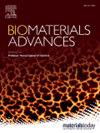Monophasic hyaluronic acid-silica hybrid hydrogels for articular cartilage applications
IF 5.5
2区 医学
Q2 MATERIALS SCIENCE, BIOMATERIALS
Materials Science & Engineering C-Materials for Biological Applications
Pub Date : 2024-11-04
DOI:10.1016/j.bioadv.2024.214089
引用次数: 0
Abstract
Hyaluronic acid (HA), an FDA-approved natural polymer and important component of the extracellular matrix (ECM), has been widely used to develop hydrogels for cartilage regeneration. However, HA hydrogels often exhibit poor mechanical properties and unsuitable degradability, limiting their capability to support cell growth in cartilage. To overcome these challenges, this study modifies HA with a silica precursor and the coupling agent (3-Glycidyloxypropyl) trimethoxysilane (GPTMS) to develop a monophasic organic-inorganic hybrid HA-silica hydrogel. In this system, the inorganic silicate and organic HA components interpenetrate and bond covalently at the molecular level. The HA-silica hybrid hydrogel achieves a compressive modulus of 143 kPa at the highest GPTMS/HA molar ratio of 400. Additionally, in vitro cell studies show that these hybrid hydrogels have no cytotoxicity against MC3T3-E1 and ATDC-5 cells. Cell viability and morphology tests further confirm excellent cell adhesion on the hybrid scaffold. These results indicate that the developed HA-silica hybrid hydrogel is a suitable candidate for cartilage regeneration applications.
用于关节软骨的单相透明质酸-二氧化硅混合水凝胶。
透明质酸(HA)是美国食品及药物管理局批准的天然聚合物,也是细胞外基质(ECM)的重要组成部分,已被广泛用于开发软骨再生水凝胶。然而,HA 水凝胶通常具有较差的机械性能和不适宜的降解性,限制了其支持软骨细胞生长的能力。为了克服这些挑战,本研究用二氧化硅前体和偶联剂(3-缩水甘油氧丙基)三甲氧基硅烷(GPTMS)对 HA 进行改性,开发出一种单相有机-无机混合 HA-二氧化硅水凝胶。在该系统中,无机硅酸盐和有机 HA 成分相互渗透并在分子水平上共价键合。在最高 GPTMS/HA 摩尔比为 400 时,HA-二氧化硅杂化水凝胶的压缩模量达到 143 kPa。此外,体外细胞研究表明,这些混合水凝胶对 MC3T3-E1 和 ATDC-5 细胞没有细胞毒性。细胞活力和形态测试进一步证实了混合支架上出色的细胞粘附性。这些结果表明,所开发的 HA-二氧化硅混合水凝胶是软骨再生应用的合适候选材料。
本文章由计算机程序翻译,如有差异,请以英文原文为准。
求助全文
约1分钟内获得全文
求助全文
来源期刊
CiteScore
17.80
自引率
0.00%
发文量
501
审稿时长
27 days
期刊介绍:
Biomaterials Advances, previously known as Materials Science and Engineering: C-Materials for Biological Applications (P-ISSN: 0928-4931, E-ISSN: 1873-0191). Includes topics at the interface of the biomedical sciences and materials engineering. These topics include:
• Bioinspired and biomimetic materials for medical applications
• Materials of biological origin for medical applications
• Materials for "active" medical applications
• Self-assembling and self-healing materials for medical applications
• "Smart" (i.e., stimulus-response) materials for medical applications
• Ceramic, metallic, polymeric, and composite materials for medical applications
• Materials for in vivo sensing
• Materials for in vivo imaging
• Materials for delivery of pharmacologic agents and vaccines
• Novel approaches for characterizing and modeling materials for medical applications
Manuscripts on biological topics without a materials science component, or manuscripts on materials science without biological applications, will not be considered for publication in Materials Science and Engineering C. New submissions are first assessed for language, scope and originality (plagiarism check) and can be desk rejected before review if they need English language improvements, are out of scope or present excessive duplication with published sources.
Biomaterials Advances sits within Elsevier''s biomaterials science portfolio alongside Biomaterials, Materials Today Bio and Biomaterials and Biosystems. As part of the broader Materials Today family, Biomaterials Advances offers authors rigorous peer review, rapid decisions, and high visibility. We look forward to receiving your submissions!

 求助内容:
求助内容: 应助结果提醒方式:
应助结果提醒方式:


